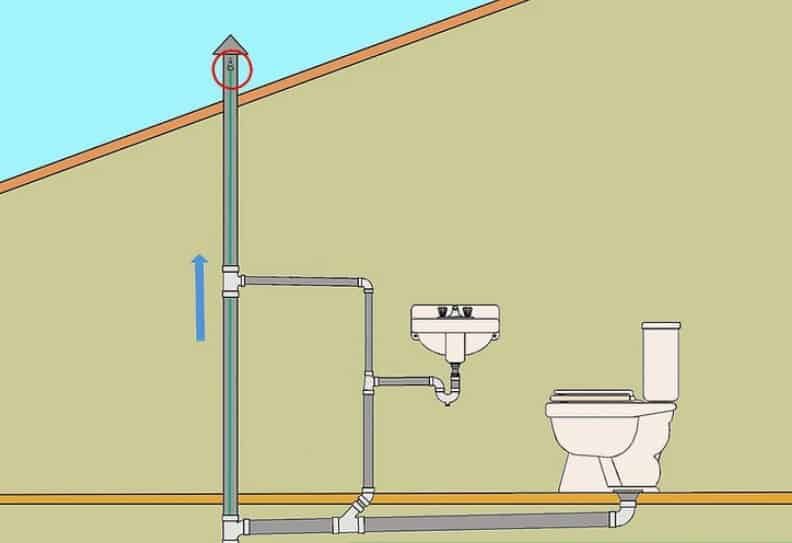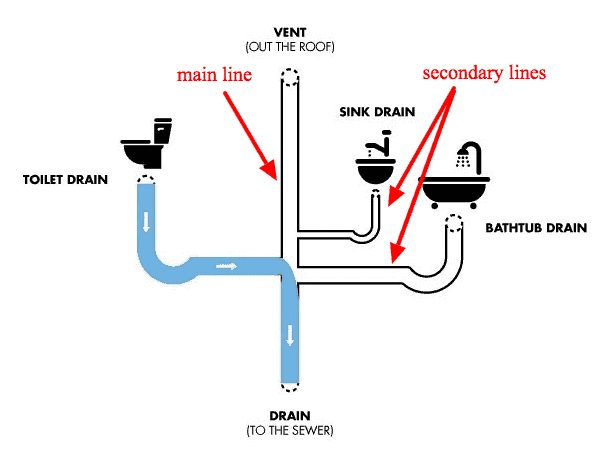It could be due to various factors if you hear strange noises from your drains. In very cold weather, for example, moisture can freeze inside and block the plumbing vent above the roof line. Blocked plumbing vents and noisy drains can have many potential causes.
Other potential causes of drain noise include:
- A build-up of debris in the drain
- A blockage in the drain
- A loose connection somewhere in the plumbing
From Skill Builder
Even if you’re unsure where the buzzing is coming from or what’s causing it, you can try a few things to figure out what’s going on. Here are some suggestions:
- Check all your drains to see if the noise comes from one.
- If the noise comes from a specific drain, try running some water down it to see if that clears the blockage.
- Check all your plumbing fixtures to see if they’re tightly connected. Loose connections can cause all sorts of strange noises.
If you’re unsure of the source of the noise or how to fix it, seeking professional help may be your best bet.
How to Reduce Noises from Your Plumbing by Adding Missing Plumbing Vents
To minimize gurgling and sluggish drains, add any missing plumbing vents.

If you’re noticing gurgling sounds or slow drains in your home, it could be because you’re missing some crucial plumbing vents. Plumbing vents help to regulate air pressure in the pipes and allow for proper drainage. Without them, your plumbing system can’t function properly.
The good news is that installing missing plumbing vents is usually a fairly easy repair. In most cases, you must add some new vent piping through the building and up to the roof. Your plumber can help you determine exactly where the vents need to be installed.
If you’re planning on doing other interior remodeling projects, it might make sense to wait and have the plumbing vents installed simultaneously. That way, they can be hidden in the walls and won’t be an eyesore in your home. Either way, adding missing plumbing vents is important in keeping your plumbing system functioning properly.
Where routing a new vent line is difficult, install vacuum breaker plumbing vents (e.g., V-200TM).

Adding missing plumbing vents is a great way to stop gurgling and slow drains. Adding a vacuum breaker plumbing vent (e.g., V-200) is an effective way to ensure proper airflow in drainage systems, but always check with your local plumbing inspector for approval before using one.
Plumbing vent piping is important for proper drainage and to avoid trap siphonage, odors, and noises. If you are struggling with any of these things, check your plumbing vents and see if they need to be added or replaced.
How to Reduce Noises from Your Plumbing By Adding Sound Insulation

The following factors influence the amount of plumbing drain noise transmitted into a room where you can hear it in the structure:
- Plastic pipe with thinner walls is less flexible, responding more slowly to sound waves.
- The close distance of the piping to areas where people live or work
- The poorly insulated pipes let in a lot of noise.
- Knowing the specifics of how the pipe was routed and supported is critical since pipes that directly touch with building framing or drywall usually make more noise.
- Pipes that were suspended using acoustic-isolating hangers, however, don’t transfer as much noise to the building interior.
How to get rid of gurgling drains?
Foam insulation is the best way to reduce drain pipe noise in an existing building. It is easy to install and will flow around pipes in the building cavity, filling the spaces completely. This will significantly reduce noise transmission.
In new construction, sound-isolating pipe hangers can be used to avoid noisy drains. Pipes can be routed around ceiling joists and wall studs to keep them from having solid contact. Insulation can be provided around the piping between ceiling joists, floor joists, or wall studs.
It would be costly and unnecessary to tear out ceilings and walls to correct these details in an existing building. Instead, blown-in foam insulation can be added to the areas where these pipes are routed.
You might utilize blown-in cellulose or fiberglass, but ensuring that the insulating materials flow around the pipes in the building cavity is more difficult. Foam insulation will expand and fill the pipe chase spaces completely.
The “blown-in” foam insulation won’t have to fill an entire wall or ceiling space, just the space where the pipes run. When confronted with extra-large spaces that need to be filled with foam insulation, it is more economical to hire a professional contractor rather than attempting to do the job yourself with little spray cans.
To do this job, the foam installer typically does not have to tear off drywall. The contractor will fill the necessary pipe routing cavities by injecting insulating foam through small openings spread out along the piping route. The result will be no more than an occasional 1/2″ diameter or fewer holes to patch and paint. After the foam is installed, there should be no plumbing noise detected in this area when the toilet is flushed on the floor above.
How to get your drains flowing smoothly again by unblocking plumbing vents?

If you notice your drains gurgling, it could be a sign that your plumbing vents are blocked. Blocked plumbing vents can cause all the fixtures served by that drain line to drain slowly.
To check if your plumbing vents are blocked, you can go onto the roof (if weather and access permit) and look for any blockages. Blockages can be caused by an insect nest, a bird’s nest, or, as shown in this photo, a frog.
In freezing climates, it’s also important to check in winter to ensure that the plumbing vents are not blocked by frost or snow cover.
Clearing blocked plumbing vents will stop your drains from gurgling and allow them to function properly.
- Fixing a freezing plumbing vent line

If you have a plumbing vent that becomes blocked by frost or ice, you will likely need to install a larger diameter vent.
First, check for leaks. If water leaks into the drain system, it can cause continuous movement of water vapor upwards through the vent system.
In freezing weather, this can condense and freeze in the outdoor portion of the plumbing vent system. You may also need a larger vent if you live in a freezing climate and your plumbing vent extends above the roof.
Installing a larger diameter vent may require effort, but preventing any future freezing and blocking of your plumbing vents will be worth it.
- Too-short plumbing vent stacks

Do you live in an area with a lot of snowfall? If so, you may have experienced the frustrating issue of a blocked plumbing vent. This typically happens when the vent stack is too short and covered by snow. As a result, the ventilation process is halted and can cause several problems for your home.
If you’re met with a frozen vent, don’t worry! Here are a few suggestions for dealing with the problem.. First, use a plunger to remove the snow and clear the blockage. If that doesn’t work, use a hose to melt the ice around the vent. Just be careful not to damage the piping. Once the blockage is cleared, your plumbing should be back up and running smoothly.
If you’re building a private basement, don’t forget to install a steam vent stack. You may avoid this problem in the future by ensuring that your plumbing vent stack is tall enough to keep snow off of it. In most cases, a few feet should be sufficient. However, you may need a taller stack in areas with very deep snowfall. These precautions allow you to keep your home safe and functional all winter.
How to Reduce Noises from Your Plumbing By Getting Rid of Sluggish or Blocked Plumbing Drains?

A blockage in the pipes, either slow or noisy, is typically caused by a small obstruction in the system. For example, Chase flushed his underpants down the toilet and created a problem.
The gurgling noise you hear coming from your drains may mean that the drain line is partially blocked, or it could be a sign of a problem with your septic system.

If your drains are gurgling, it could signify a partial blockage in the drain line or a sluggish septic system. This can happen when waste piping to a septic tank or from a septic tank to a drain field is affected. Usually, the outside sewer line is only partially blocked.
The symptom may be more pronounced if the inadequate building drains the vent system. If you use your facility’s fixtures more frequently, such as when there are many people or when doing laundry, the additional water volume may cause the “gurgling drain” symptom more apparent. When the obstruction worsens, the building drains may become clogged during heavy usage.
If this happens, you could also start to notice sewage smells or sewer gas backups in your building.

